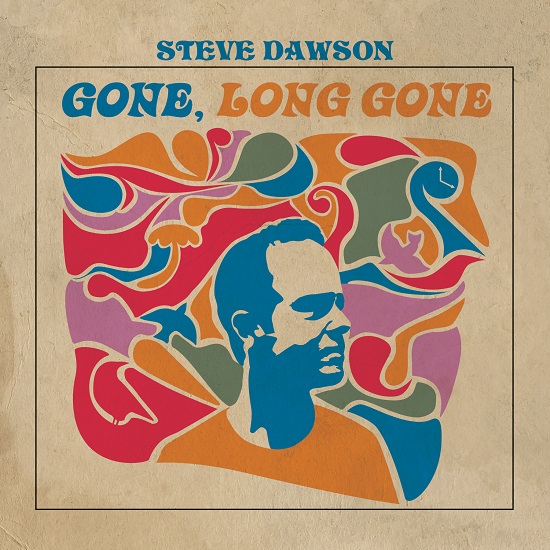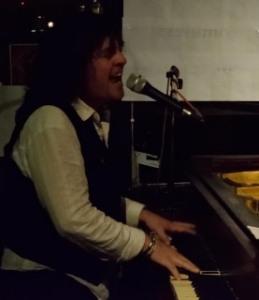
We’re still seeing and hearing albums created during the lockdown using remote technology; this one’s a bit different in that it’s the first of three albums recorded by Steve Dawson during the pandemic featuring songs that might otherwise never have been released. The ten songs on “Gone, Long Gone” reflect the eclectic nature of Steve Dawson’s work as a performer and producer. As a multi-instrumentalist and keen student of musical history, Steve brings a wide range of influences and musical knowledge to anything he does; his own album is no exception. Of the ten tracks, there are two contrasting instrumentals, showcasing Steve’s exceptional guitar skills, seven songs co-written with the brilliant Matt Patershuk, and one cover.
The cover is a song that everyone with any interest in music at all seems to love (apart from Rod Stewart, who apparently refused to sing on the Faces studio version of the song). Steve takes it at a very relaxed pace, building up to big harmonies in the chorus and showcase solos towards the end. It’s not quite as punchy as the original, but it’s an honest effort and a lovely homage. The two instrumentals demonstrate different facets of Steve’s work: his interest in Hawaiian music shines through “Kulaniapia Waltz”, creating an authentic feel with ukulele and steel guitar, plus the not-so-authentic pump organ while “Cicada Sanctuary” is a solo acoustic guitar piece inspired by hearing the noise of massed cicadas and being inspired to play something that fitted the mood. Both are very evocative mood pieces.
The remaining seven songs are the Matt Patershuk co-writes. Steve has always been wary of the collaboration process, but Matt’s a good friend and he’s a songwriter that knows how to write something that’s a bit different. The results are very impressive; “King Bennie had his Shit Together”, a fictionalised take on the life of Hawaiian steel guitarist King Bennie Nawahi, set against a backdrop of a jazzy bluegrass shuffle, tells an interesting story, cleverly pulling the listener into the first-person narrative of the tales of an old musician.
You can find historical musical references dotted throughout the album; the opener “Dimes” is a bit of fun that hints at Little Feat, “Bad Omen” and “6 Skeletons in a Car” (not as gruesome as it sounds) both have a brooding, menacing Southern groove feel while “I Just Get Lost” jumps into a chorus that strongly echoes The Beatles’ “Revolution”. You get the picture; there’s a lot of variety and you never quite know what’s round the next corner.
“Gone, Long Gone” is an album for people that want to actually listen to music, rather than passive consumers; the quality of the songwriting, playing and arrangement deserves much more than that. It’s out now on Black Hen Music (BHCD0096).
Here’s the official video for the album’s opener, “Dimes”:
 So Southend-on-Sea on a Sunday night and what’s happening? Well, the Bob Malone Band is playing at the Railway Hotel, that’s what. So you obviously want to know what’s so special about the venue and the performer, don’t you?
So Southend-on-Sea on a Sunday night and what’s happening? Well, the Bob Malone Band is playing at the Railway Hotel, that’s what. So you obviously want to know what’s so special about the venue and the performer, don’t you?
Southend has a thriving local music scene and the Railway Hotel is positioned firmly at the centre of that scene, featuring local talent and artists touring the UK. The venue isn’t a highly-polished chrome and mirrors palace; the priority here (apart from the excellent food) is live music. If you want anything else, then you’re in the wrong place. The management team excel in putting together a varied selection of live acts and providing a performance environment which is perfect for artists and audiences.
So, Bob Malone time. Bob has been working as a professional musician for around thirty years since graduating from Berklee, playing keyboards for a very impressive list of rock names while doing his own thing, touring with a small band and releasing six albums (and counting). The UK tour which ended at the Railway Hotel was in support of a UK-only EP which is a sampler for the upcoming seventh album.
The stage at the Railway is about the same size as a postage stamp, which makes for a cosy performing environment, particularly when most of the stage is occupied by a Bӧsendorfer grand piano, but the multinational band (Paul Carmichael on bass, Stefano Sanguigni on guitar and Marco Breglia on drums and backing vocals) just got on with it, although Paul Carmichael had to play most of his superb basslines with his back to the audience.
From the opening chords of “Why Not Me?”, Bob’s engaging manner between songs and his blues growl have the audience eating out of his hands, and that’s before you hear his superb piano playing, particularly on the skewed ragtime of “Chinese Algebra”. You can find any amount of versions of this on YouTube, but the live performance with a good band is something else. The set was split between material from the new “Mojo EP” (including “A Certain Distance”, “I’m Not Fine” and the audience favourite “Rage and Cigarettes”), older original material and a few high-profile covers. Bob Dylan’s “Tangled Up in Blue” is the first of the covers and the set ends with a version of The Faces classic, “Stay with Me”. It’s the end of the set and the end of the tour and the guys (particularly Bob and Stefano) are having great fun trying to be even looser live than Rod and the boys were in the 70s. I could happily listen to Bob on his own doing the New Orleans piano, voice and stomp box thing, but Paul’s fluid, funky bass, Stefano taking a few solos and Marco supplying the beat and some lovely backing vocals are the icing and the candles on the cake.
I’m only guessing here, but I suspect that Bob Malone could live quite well on the proceeds of the day job, playing live and in the studio with people like John Fogerty, and living in the bubble created by that lifestyle. Instead he chooses to do his own thing, recording his own work and taking his live band out on the road, driving a white van from town to town and playing in venues where the equipment’s held together by gaffer tape. I have the greatest admiration for anyone who chooses to step between those two worlds to pursue their own musical vision, whether it’s financially viable or not (the fee for the night at The Railway was a bucket collection from the audience). As long as some performers are true to their own vision and keep doing gigs like The Railway, we’ll all know that individualism lives on and the corporate monster hasn’t got complete control. I can’t wait for the new album now.


